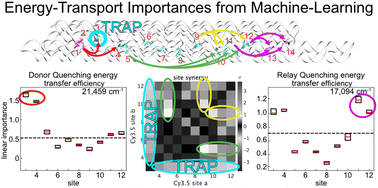Determining interchromophore effects for energy transport in molecular networks using machine-learning algorithms†
Abstract
Nature uses chromophore networks, with highly optimized structural and energetic characteristics, to perform important chemical functions. Due to its modularity, predictable aggregation characteristics, and established synthetic protocols, structural DNA nanotechnology is a promising medium for arranging chromophore networks with analogous structural and energetic controls. However, this high level of control creates a greater need to know how to optimize the systems precisely. This study uses the system's modularity to produce variations of a coupled 14-Site chromophore network. It uses machine-learning algorithms and spectroscopy measurements to reveal the energy-transport roles of these Sites, paying particular attention to the cooperative and inhibitive effects they impose on each other for transport across the network. The physical significance of these patterns is contextualized, using molecular dynamics simulations and energy-transport modeling. This analysis yields insights about how energy transfers across the Donor–Relay and Relay–Acceptor interfaces, as well as the energy-transport pathways through the homogeneous Relay segment. Overall, this report establishes an approach that uses machine-learning methods to understand, in fine detail, the role that each Site plays in an optoelectronic molecular network.

- This article is part of the themed collection: 2023 PCCP HOT Articles


 Please wait while we load your content...
Please wait while we load your content...